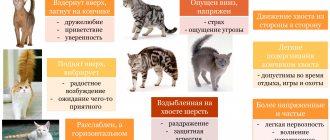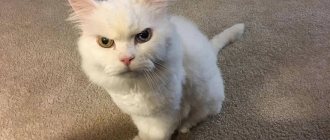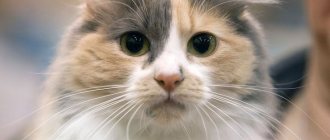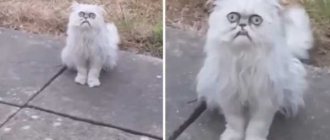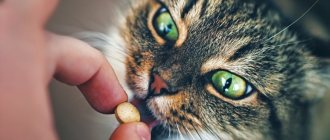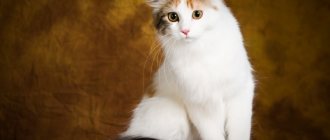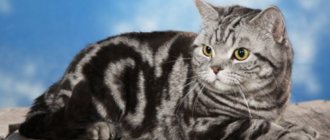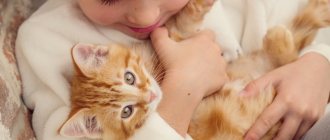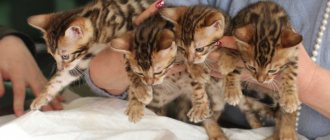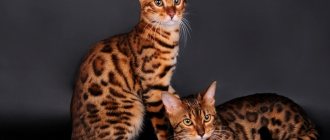A cat with squint is not uncommon, especially among certain breeds. Many owners even like this feature, but how much does this pathology affect the well-being and quality of life of the animal? The disease has several stages of development; in the initial stages it is quite difficult to identify deviations. However, if you suspect that your cat is cross-eyed, you should take her to the vet. If the pathology is congenital, then it will not affect the quality of life of the animal, but if strabismus has developed as a result of injuries or other diseases, the situation should not be left to chance under any circumstances.
Maintenance and care
It is easy to care for the coat of such animals; it is enough to thoroughly comb it weekly with a special brush.
It is not recommended to bathe the blue-eye often - 1-2 times a month will be enough. Bathing is carried out using cat shampoo and conditioner, and then wipe the pet dry with a warm terry towel and do not let it out into drafts. Eyes and ears should be washed as they become dirty with cotton pads soaked in warm water, or the ears should be treated with a soft cloth. The use of cotton swabs to clean ears is strictly prohibited, so as not to harm the animal. Pay special attention to the animal’s mood, as it is characterized by a touchy character. Because of this feature, a cat may fall into a prolonged depression and refuse to walk, eat or drink.
The right way to get rid of an animal’s depressed state is to give it maximum attention, provide it with care, affection and love. In your free time, you should try to keep your cat busy with active games as much as possible.
Breed characteristics
Standard
- Appearance: The Tonkinese cat should give the impression of a compact, proportionally built animal, neither strong nor thin in build. The animal should not be light in weight, despite its small size. This is a muscular cat, active and emotional.
- Torso: should not give the impression of being squat or excessively slender; proportionality is preferable to size. The muscles are well developed, but not excessively.
- Legs and paws: quite graceful, proportional to the body. The hind legs are slightly longer. The paws are small and oval.
- Tail: medium length, proportional to the rest of the body, pointed at the end.
- Head: wedge-shaped, but rounded, with high, non-sharp cheekbones, clean contours. The edges of the chin and nose are on the same vertical line. The transition between the forehead and nose is not sharp, the forehead is slightly convex.
- Ears: Proportional to the body, medium in size and rounded at the tips. Set so wide and high.
- Eyes: proportional to the rest of the muzzle, almond-shaped, open. Deep and pure shades are desirable, from aquamarine to sea green.
- Coat: short, close-lying, shiny, silky to the touch, without undercoat.
Colors
The “calling card” of the breed is the mink color, when the dark color of the points smoothly transitions to a lighter color of the body. In adult animals, the mask and ears are connected by tracing (dark paths). With age, the animal darkens, the color “blurs out”. The following variations are allowed:
- natural mink;
- champagne mink;
- blue mink;
- platinum mink.
Photos of colors
Solid colors (Burmese) with eye color from green to yellow-green, pointed (Siamese) with blue eye color are also allowed. The color variations are the same.
Animals are disqualified from:
- yellow eyes;
- squint;
- white medallions;
- crooked tail.
Health
The weight of representatives of the breed ranges from 2.5 to 5.5 kg, males are larger than females. In general, Tonkinese cats have good health. With proper care, they can live 15 years or more.
However, “bad heredity” sometimes makes itself felt. There may be problems with teeth (as with Siamese), and liver amyloidosis - representatives of all breeds of the Siamese-Oriental group are prone to it. The instability of Tonkinesis to upper respiratory tract infections is also noted.
Personality of the Tonkinese cat
The Tonkinese, due to its relationship with the Siamese, has a lively and friendly character. Such a pet strives to communicate with all family members, including other animals. These cats adore their owners and love to tell them all their cat news, except that their voices are softer and quieter.
Representatives of the Tonkinese breed feel good in any, even noisy, family and get along with children - provided that adults have explained to them how to behave with an animal. It is believed that communication with tonkinesis has a positive effect on the condition of a child suffering from certain mental disorders.
Charming cross-eyed cat named Belarus (photo)
A cat with an unusual name for the United States, Belarus, lived in a San Francisco shelter, where his previous owners gave him.
Cats and other pets could not be kept in that house due to the tenant's rules, so the family was forced to give the pet to a shelter.
According to Deb Campbell from Animal Care and Control San Francisco, Belarus is a very soft, fluffy, slightly cross-eyed, but incredibly affectionate and friendly cat.
In addition, he is extremely sociable and always requires human attention. When someone came to the shelter to choose a cat, Belarus was always in the foreground and even stood up by the hind legs and looked into the person’s face, as if asking, “Maybe it’s me that you need?”
For some time no one took Belarus, perhaps because of his strabismus, or maybe for other reasons. But one day Rachel saw his photos on Instagram.
“When I saw his unusual eyes, I immediately fell in love with this cat,” she says, “and immediately began planning how I could get to this shelter.”
When they finally met, the cat sweetly snuggled up to the woman and Rachel realized that she would take him home.
Belarus quickly got used to his new surroundings and became a little gray shadow for Rachel. Wherever she went, he followed her. He couldn't bear to be alone.
“He's constantly watching me. Especially in the morning when I go to the bathroom. You could say that with this cat in the house, I lost my privacy,” Rachel jokes.
According to the woman, Belarus is a big cat not only in kilograms, but also as a person. When the cat came to her, he was only about a year old, and then he grew even more, but did not stop behaving like a kitten.
In addition to observing his owner, Belarus loves to play with balls and other cat toys.
When Rachel takes a bath, the cat always sits outside and waits for her to come out, and when she brushes her teeth, he sits next to the shelf and looks in the mirror.
For Belarus, Rachel leaving for work is a big loss and he is very happy when she finally comes back. He immediately begins to spin around her and demand attention.
Belarus inspects the refrigerator
And a dishwasher
“When I sit on the sofa in the evening and watch TV, he lies close to me. He falls asleep next to me or licks himself, but never leaves me a single step.”
And when Rachel turns on the computer, the cat is right there too.
“He's also good with typical cat things, like when he paws things off the shelves and they fall down.”
Congenital strabismus makes the cat's facial expression especially expressive.
It's been four months since Rachel took Belarus into her home.
Breed of cross-eyed cats
The occurrence of strabismus in these breeds is associated with the acromelanism gene - the same thing that gives the cat a smart, elegant color-point coat (dark-colored limbs with a light, often cream-colored body) and sky-blue eyes.
READ Jagdterrier training in Moscow and the Moscow region!
This gene is in a certain way associated with the abnormal development of the optic nerve, which leads to the fact that the animal sees a double image: objects seem flat, and attempts to piece together a double image causes persistent strabismus, sometimes accompanied by nystagmus (frequent oscillatory movements of the pupil, usually from side to side).
Of course no. In fact, obvious strabismus is strictly rejected by felinologists, so to say that Thais or Siamese are a breed of cross-eyed cats is not entirely correct.
Acromelanic coloring, of course, is a risk factor, but a cat with slanted eyes can also appear in the litter of cats belonging to the Siamese-Oriental group of breeds, as well as among Sphynxes, Scottish Folds and Straights. Moreover, strabismus can occur in kittens obtained by mixing different breeds, or even outbred ones. Albino cats also occasionally suffer from strabismus and/or nystagmus.
Due to the fact that cats with strabismus look touching and special, their owners do not miss the opportunity to show everyone around their special pet.
But a ginger cat from California named Jarvis was found by his current owners on the street at 4 weeks of age. Apparently, the previous owner, having noticed a flaw in the kitten in the form of slanted eyes, decided to get rid of it in this way. The cat was picked up by a local resident and at first wanted to give him to a shelter, but then she changed her mind and kept the baby with her.
The cat Jarvis gained fame and was loved by millions of people when his owner posted his photos on the Internet.
People couldn't ignore such a charming and funny ginger cat. And Jarvis’s owner herself says that the cat has been incredibly smart, active and cheerful since childhood, and she is very glad that she did not give him to a shelter
Genetic mutation, pathology, disease – whatever they call heterochromia in domestic cats. However, there are cat lovers who are convinced that such animals bring good luck. What is remarkable about the breed of cats with different eyes you will learn from this article.
Interesting facts about exotic cats
- The Cat Fanciers' Association (CFA) annually calculates breed rankings based on the number of registrations of pedigreed cats. According to this organization, in 1999 exotics took fourth place in the world in popularity, and in 2012 they took second place, second only to their ancestors - the Persians. Since the age of 14, they have been confidently leading. However, in Russia the situation is different and here, in terms of demand, exotics hardly make it into the top ten breeds;
- Life is hard for show exotic cats. To improve their coat, they are constantly bathed - once or twice a week for two or three months before the show. And kittens who need to make a career have to take a bath 2 times a week, starting from 3 months of age;
- Cats make a career not only at exhibitions. They acquire millions of fans in the virtual space, of course, with the help of loving owners. Among them is the cutie exotic Snoopy, red van color. His name began to be used as a common noun for the entire breed. Snoopy was born and has been living in China since 2011, and his owner is diligently promoting her pet. He does not have any talents, he simply advertises his breed and demonstrates what a well-groomed exotic should look like;
- Initially, they planned to name the breed “Sterling” - silver, since the kittens offered by CFA as a sample were obtained from chinchilla Persians and had a silver color. But since this name narrowed the idea of the new breed, the association council preferred a more capacious one: “exotic shorthair”, allowing in the breed standard a variety of colors typical of Persians;
- After the recognition of the breed in 1966, exotics had a rapid career. In 1971, the exotic was awarded the title of CFA Grand Champion. The black smoke cat named Docia Dao Triby received the CFA National Winner award three times. In 1991, the exotic brown tabby Jovanthe Legend was recognized as the best cat of the year.
Cat Breeds Prone to Strabismus
Cats of any breed can have strabismus, but there are animals among which it is most common:
- Siamese;
- Thai;
- snow-shoe;
- Balinese;
- Javanese.
Cross-eyed Siamese cat
This phenomenon is associated with a special gene called “acromelanism”. It is he who gives cats an unusual color of fur and eyes (dark paws and tail, light body and bright blue eyes). But this gene gives cats not only beauty, because of it the optic nerve develops incorrectly, the cat sees everything in double form, and objects look flat. Attempts to put it all together and take a better look lead to the pet acquiring slanted eyes, sometimes the pupils move from side to side.
Kitten with eyes in different directions
Home
Questions and Answers Cats Diseases and health of cats
Many small kittens have a rather strange look - their eyes either run away in different directions, or converge in a bunch. Sometimes one eye looks up, and the other straight or to the side. This gives the babies a rather stupid look and frightens their owners - what if the kitten has problems with its eyes and may go blind? Why do kittens have slanted eyes?
Exotic kitten from the nursery of exotic Himalayan Persians “Angel’s Kiss”
Small kittens up to a month old almost always mow, just like newborn children. The fact is that they do not yet know how to control their visual muscles. Babies of any kind are clumsy in everything at first - they crawl instead of walk, they do not know how to eat and do many actions that adults can easily do. They need time to learn to control the muscles not only of the body, but also of the eyes, to learn to focus them and synchronously direct them in one direction.
In the meantime, babies don’t yet know how to do this, their eyes wander each on their own, and there’s no need to be scared. In some purebred cats, strabismus disappears only by ten months , but most kittens acquire a normal, meaningful look by 5-6 weeks.
Exotic kitten Aishun's Vasia from the Aishun nursery
But if time passes and the squint does not go away, then your pet really has vision problems. To determine exactly what abnormality your cat has, you need to take him to a veterinary ophthalmologist. Most often, strabismus must be corrected through surgery .
Source
What is strabismus
The disease is otherwise called strabismus. Strabismus is a deviation in which the visual axes are directed in a different direction from the object in question. With strabismus, in cats, the coordinated work of the eyes and their fixation on any object are disrupted.
Strabismus can affect one or both eyes at once. If the pupil (or pupils) is directed towards the nose, this indicates converging strabismus. The direction of the pupil in the opposite direction is called divergent strabismus.
Clinical picture and types of strabismus
The acquired disease in animals can develop unilaterally or bilaterally. In the first option, only one eye changes its anatomically correct position, in the second case, respectively, two. Both eyes move in their orbits; several small muscles are responsible for this function. Strabismus occurs when the functioning of these muscle tissues is disrupted and the eyeball is displaced.
Molossians (dogs): breed varieties and overview
In the vast majority of cases, deviations can be detected visually. A clear sign of strabismus is evidenced by asymmetrically located corneas and pupils.
Note! If an animal fixes its gaze on a certain object, but its eyes are fixed differently, then this indicates the presence of pathology.
Representatives of Siamese and Oriental breeds often have pupils close to the nose. This form of pathology is called convergent. If, on the contrary, the pupils are distant from the nose, then this form of the disease is called divergent. The first form is the most common and is often congenital.
Unilateral strabismus in cats
Is strabismus dangerous in cats?
What does squint mean?
Strabismus in cats is a rare occurrence. It may affect one or both eyes. Strabismus is often explained by pathologies of the muscles of the eyeball or the nerve fibers that send signals to the muscles. There are usually no problems with the eyeballs themselves during strabismus. With convergent strabismus, which is also called convergent strabismus, the furry pet's eyes seem to be fixed on the bridge of the nose. With divergent strabismus, both eyes seem to be trying to see objects on the sides, the pupils are close to the outer edges of the eyes. Dispersive strabismus is also called dispersive strabismus.
But if your mustachioed pet with normal eye position suddenly begins to squint, this is a signal of malaise, injury or an internal pathological process. In this case, the four-legged animal must be urgently shown to a veterinarian. Let's consider the situations described in more detail.
Strabismus as a congenital feature
It happens that strabismus in cats is temporary. It appears at the very beginning of life and gradually fades away by about five months of age. A newborn baby opens its eyes a couple of weeks after birth. If his eyes cross, don’t rush to conclusions. Tiny muscles control the position of the eyeball. In newborn kittens, these muscles are not yet strong enough. It is necessary to provide the baby with proper nutrition and care. If the kitten is already five months old or more, and the strabismus does not disappear, then this is a genetic feature. Your pet will have this outlook on life forever. But strabismus in cats has almost no effect on the quality of vision. The furry creatures themselves will not think that there is anything wrong with their eyes. Cats with strabismus walk without problems and hunt successfully. And some become Internet celebrities. Such as the cross-eyed cat Spangles from the USA.
Where is the connection between breed and the tendency for strabismus in cats? It's about the acromelanism gene. Thanks to him, cats boast a color-point color - light fur on the body and dark fur on the ears, paws and tail, their eyes are blue or light blue. This gene is associated with the development of the optic nerve.
But representatives of other breeds are also born and live with strabismus. Cats with this feature are obtained by mixing breeds; strabismus often occurs in outbred cats.
We emphasize that congenital strabismus is quite often accompanied by congenital nystagmus. This is the name given to rhythmic, oscillatory movements of the eyes in the horizontal plane.
When to sound the alarm
Much greater concern is caused by cases where strabismus appears suddenly in adult cats. This is a signal that something has gone wrong in the body. The sooner you show your cat to a veterinarian, the higher the chance of normalizing your pet’s vision, identifying hidden health problems and successfully providing treatment.
You will need to consult a veterinary ophthalmologist. The specialist will evaluate your pet's reflexes and measure eye pressure. If it is elevated, it may indicate glaucoma. A veterinarian may refer your pet for an ultrasound, tests, MRI of the brain, X-rays and other additional examinations. Tell the doctor what events in your patient's life could have affected his health. It is possible that a fall from a height or other damage is to blame.
If strabismus is caused by problems with the vestibular system, injury or inflammation, the doctor will usually prescribe medication. If a veterinarian detects tumors in the orbits of the eyes, this problem is solved with the help of surgery. Eliminating the root cause of strabismus helps normalize your pet's vision.
The sooner you pay attention to changes in your patient’s condition, the greater the likelihood of a favorable treatment outcome. We wish you and your pet health!
Diagnostics
First of all, the veterinarian prescribes a series of tests to exclude or confirm the presence of an infectious disease. To do this, he prescribes urine and blood tests, as well as performs an ultrasound and takes an x-ray. Additionally, a specialist may recommend an MRI. Next, the eyes are examined by a veterinary ophthalmologist. It checks reflexes and intraocular pressure.
It is important! In most cases, strabismus is one of the symptoms of a serious disease or pathology.
Character and temperament
Caracat is a hybrid cat with a pleasant, but rather contradictory disposition. From his wild ancestor he inherited the desire for independence and independence. Therefore, you should not expect that the caracat will turn into a pet.
Representatives of the hybrid breed inherited an affectionate, obedient and non-aggressive character from domestic cats. Curious and energetic caraquets never give up on outdoor games and enthusiastically take part in all household chores. Representatives of the breed need constant communication with people and easily tolerate changes in environment. Caracats love nature walks and road trips.
Patient and non-aggressive caraquets do not pose a danger to the owner's children. But if the child is too pushy, the hybrid cat may hiss or release its claws.
The caraquet gets along well with other pets, with the exception of decorative rodents and birds. A strong hunting instinct prevents a hybrid breed cat from making friends with hamsters or parrots.
Vaccinations and antiparasitic treatment
To protect the Tonkinese cat from viral and infectious diseases, it is systematically vaccinated against rabies, panleukopenia, rhinotracheitis and calcivirosis. The first vaccination is given to a kitten at 7-8 weeks and repeated after 28 days. Subsequently, the Tonkinese is vaccinated once a year.
To prevent diseases transmitted by parasites, the cat is regularly treated for worms and fleas. Representatives of the Tonkinese breed are given anthelmintic medications once every six months, repeated every 10-14 days. Protect against Tonkinese fleas with special collars, drops and shampoos.
Freckles
On the noses of some cats you can see small spots of black or brown color, ranging in size from 1 to 10 mm. There can be either one or two, or a large number, in which the spots merge into one.
These peculiar “freckles” are called lentigo and are pigment spots formed as a result of increased activity of cells producing the melanin pigment. Lentigo occurs in cats not only on the nose, but also on the lips and gums.
Pigmentation is genetically determined, inherited and most often occurs in cats whose color is predominantly red. However, not all red-haired pets can boast of such “freckles.” Scientists have yet to figure out why they occur in some animals and not in others.
Owners should remember that lentigoes are benign formations that will never develop into melanoma. They do not cause cats any discomfort and do not require a visit to the veterinarian.
The most common causes of pathology
Firstly, as we have already said, strabismus can be congenital (the reasons for this phenomenon have not been studied). This phenomenon is especially typical for “Scots”, Persians, Siamese cats, as well as crossbred animals. It does not have any negative effects, except for mild myopia in cats. Note that congenital strabismus is very often accompanied by congenital nystagmus.
This is especially true for Siamese and Sphynx cats. Both of these pathologies are practically the norm for cats of the named breeds; no treatment is required (and it will not help). Other causes of strabismus in cats:
Hydrocephalus, that is, dropsy of the brain. It happens that this is associated with strabismus in kittens.
Infection with feline leukemia virus.
Inflammation of the middle and/or inner ear, as well as meningitis or encephalitis.
Injury or inflammation of the muscles of the eyeball itself. This happens extremely rarely in cats, but occurs in Britons.
Cancer of the brain or optic nerve.
Provoking factors of development
Feline strabismus is medically called strabismus. Pathology can be either congenital or acquired. In the latter case, the defect develops against the background of injuries - severe blows to the head or due to falls. Also, a kitten can become cross-eyed after certain diseases:
- developmental pathologies or disturbances in the functioning of the vestibular apparatus (disorientation);
- encephalitis is a viral pathology accompanied by inflammation of brain tissue;
- dysfunction of the central nervous system organs;
- hydrocephalus or dropsy - a disease accompanied by the accumulation of cerebrospinal fluid in the head;
- rabies;
- meningitis - inflammation in the mucous membranes of the brain or spinal cord;
- otitis of the middle or inner ear;
- glaucoma – sudden changes in pressure inside the eye;
- The feline leukemia virus is a disease whose symptoms are very similar to cancer.
A dog whose eyes fall out: a review of breeds
Strabismus sometimes appears due to a hereditary predisposition. If the genetic eye disease is mild, then there is no need for treatment. Oblique cats quickly adapt and are able to lead a full life.
Important! A purebred cross-eyed cat should not be allowed to be bred in the future. After injury, due to physical impact, the eyeball deviates from its usual, correct position
Diseases that affect muscle tissue can also provoke strabismus. The cause of the shift may be the development of a neoplasm inside the orbit or the occurrence of inflammatory processes
After injury, due to physical impact, the eyeball deviates from its usual, correct position. Diseases that affect muscle tissue can also provoke strabismus. The cause of the shift may be the development of a neoplasm inside the orbit or the occurrence of inflammatory processes.
Problems in the functioning of the vestibular apparatus lead to the fact that the eyeballs can change their location. The fact is that thanks to the vestibular system, a cat can navigate in space. If something doesn’t work correctly, the brain is not able to correctly perceive information about the position of the head, which, in fact, becomes the cause of strabismus.
Clinical picture of rabies in cats
The development of strabismus can also be provoked by a disturbance in the interaction of the organs of the nervous system (CNS) with the organs of vision.
Note! The occurrence of malignant processes in the brain quite often provokes the development of strabismus
Is correction required?
Hereditary strabismus is only an external feature that does not cause any inconvenience to the cat and does not harm it.
It’s another matter if strabismus was acquired in adulthood, then immediate help from a specialist is needed. To accurately diagnose problems with the nervous system and vestibular system, an MRI of the eye orbits or brain may be required.
For various inflammatory diseases, drug treatment is necessary, which is prescribed by a veterinarian. With proper and timely therapy, strabismus in your cat will be completely cured.
If the problem of strabismus is associated with various injuries or damage to the eye muscles, then there is only one way out of the situation - surgical intervention. The operation will have a good outcome only if the disease is detected at an early stage. Otherwise, the animal will face unpleasant consequences for its health and well-being.
That is why it is so important to promptly contact a veterinary clinic as soon as the disease is identified.
Short tail
It is noteworthy that the presence of a tail in a “rudimentary” state or its complete absence in cats is a sign of “noble” origin (in contrast to the same domestic dogs, whose tails are docked deliberately - to fit the animals to the standards of a particular breed). It is worth noting that there are only a few types of short-tailed/“tailless” cat breeds, which include:
Kurilian Bobtail
a short curved tail approximately 5-9 cm long, resembling a fluffy pom-pom and characterized by mobility, a relatively small body with strong bones, developed muscles and limbs of medium length, a triangle-shaped head with medium-sized eyes corresponding to the color, short-haired or semi-long-haired, but in in any case, with a fluffy collar on the neck and chest.
more details
American Bobtail
a short and flexible tail from 2.5 to 8 cm long (it can be straight, curved, and slightly curled at the end), a body of medium length with an athletic build and strong paws proportional to it, a round muzzle with strong jaws and ears, an internal the surface of which is covered with long fluffy hairs, short or long hair, but always thick and slightly harsh.
more details
Japanese Bobtail
a short tail no more than 12 cm long (straight, curled, curved or in the form of a pompom), a long and lean body with a flat back and slender legs (the hind legs are noticeably longer than the front ones), a muzzle with large oval-shaped eyes and large, wide-set ears, soft and silky coat of medium length.
more details
Mekong Bobtail
a short and broken tail with a length of at least three vertebrae (but no more than a quarter of the length of the body itself), a strong and muscular body of medium size with long legs, a wedge-shaped head with medium-sized ears (with rounded tips) and slightly slanted eyes, always bright blue , short silky coat with minimal undercoat.
Karelian Bobtail
a short tail 4-13 cm long (can be either kinked or almost straight), a strong body with an even posture and proportional paws, a narrow head with a small strong chin and rather large ears with tiny “tassels”, short or long hair ( necessarily dense).
Kurilian Bobtail
“no, not a relative”
short tail 3-8 cm long (with pronounced kinks), strong build with a slightly arched back and powerful paws, large trapezoidal head with a powerful chin and proportional ears, short or long hair (very soft to the touch).
more details
Pixiebob
short straight (but possible kinks) tail about 5 cm long, large and muscular body build with powerful bones and a clearly defined arch on the back, large pear-shaped head, tightly knit and strong paws (the hind legs are noticeably longer than the front ones), short or moderately long hair with different color options, but always with small or medium spots throughout the body.
more details
Manx cat
they may either have no tail completely, or have a small “stump” hidden under the fur, or generally have a tail of normal length, a medium-sized round body with a round head, powerful limbs with well-developed muscles (the front ones are noticeably shorter than the back ones), round eyes with a slight slant, short and thick coat, like “plush”.
more details
Cymric cat
Kymrik
tailless breed (but there can be either a “stump” or even a full tail), a tightly built physique with a wide chest and an arched back, short front and long hind limbs (with heavy shins), thick hair of medium length.
more details
Treatment of strabismus in cats
Therapeutic methods of strobism, duration of treatment, and prognosis largely depend on the root cause that provoked the development of this pathology. Congenital strabismus can usually be eliminated surgically. But it must be borne in mind that in representatives of the Siamese breed the operation will not correct, but will only worsen the situation, since in this way the furry pet’s nervous system tries to adapt to its individual physiological characteristics. In this case, strabismus can be considered a cosmetic defect that does not pose any danger to the health of the animals.
If acquired strabismus in cats has developed against the background of pathologies or chronic infections, the veterinarian, after diagnosis, prescribes comprehensive treatment. Animals are prescribed general and local antibacterial drugs, antipyretics, and systemic medications.
In case of ruptures of the internal muscle structures of the eye, or the presence of pathological neoplasms, a complex surgical operation will necessarily be prescribed. But it should be noted that the operation will be effective and efficient only in the initial stages of ophthalmological pathology. Therefore, if you notice signs of strabismus in a cat, do not delay your visit to the veterinary hospital.
Signs and types of strabismus
Strabismus in cats can be unilateral, when only one eyeball deviates from its normal position, or bilateral, when the disorder extends to both eyes. The eyeballs are mobile, and their joint movement in the orbits is ensured by several small muscles. If, for some reason, the coordinated work of these muscles is disrupted, or the eyeball is displaced relative to its correct position within the orbit, then strabismus occurs.
In many cases the problem can be determined visually, but this is not always possible. If the cat's eyes are oriented differently, the pupils and corneas are asymmetrically located, these obvious signs will indicate strabismus. If the asymmetry is not too obvious or not noticeable at all, you can observe the cat. If, while looking at an object, her two eyes fixate on it differently, she probably has strabismus.
In some cases, strabismus is not accompanied by a clear turn of the eyeball in any direction, while the pupil may have the usual round shape, and the eye is no different in appearance from a healthy one. To check your suspicions and, if necessary, begin treatment, the cat owner needs to contact a specialist.
Eye diseases in cats
Eye diseases in cats are a large group of diseases. Some of them are inflammatory (infectious), some are non-inflammatory (non-infectious).
Conjunctivitis
The most common inflammatory eye disease in cats.
Causes
May occur due to injuries, allergic reactions, foreign bodies, chemicals, infectious diseases, vitamin deficiencies, etc.
Symptoms
Conjunctivitis is indicated by:
- milky pale film;
- the animal constantly rubs its eye;
- discharge from the eyes.
Treatment
Catarrhal conjunctivitis is treated with aqueous solutions of drops of 0.25% chloramphenicol, 10% sodium sulfacyl instilled into the conjunctival cavity, 2-3 drops 3-4 times a day.
For purulent conjunctivitis in a cat, wash the eyes with a solution of furatsilin (1:5000), solutions of antibiotics, sulfonamides. Use tetracycline, erythromycin and other ointments (place 2-3 times a day in the conjunctival cavity). Intramuscular administration of antibiotics is possible.
Conjunctivitis is a contagious disease. It is necessary to isolate the cat from other pets, and after contact with a sick animal, wash your hands thoroughly.
Injuries
The most common eye pathology is non-infectious. It is especially common in cats that go outside. If a family has several pets, then fights between them are possible.
Causes
- scratches (claws, hard objects);
- falling from a height;
- attack by aggressive relatives and dogs;
- foreign body entering the eye;
- punctures;
- bruises;
- bites;
- lacerations.
Symptoms
- redness of the eyes;
- tearfulness;
- pain syndrome;
- swelling;
- discharge from the eyes.
Treatment
Treatment comes down to antibiotic therapy, anti-inflammatory and painkillers (ointments, eye drops). In difficult cases, surgery may be required.
Entropion and eversion of eyelids
Causes
Turning inward or turning outward of the edges of the eyelids occurs due to injuries, inflammatory processes, burns, and with a reflex spasm in acute conjunctivitis.
Symptoms
- the eyelashes and the edge of the eyelid are turned inward;
- wet eyes;
- severe lacrimation;
- redness of the conjunctiva.
Care
Thai cats are clean and can lick their fur for several hours. Even due to increased activity, pets do not damage furniture. But a small kitten still needs to be accustomed to a scratching post and a tray.
A warm climate is very important for a pet. Since keeping them in cold conditions, in addition to colds and other diseases, can cause color changes.
It is imperative to provide the cat with free space where she can play and frolic.
Wool
Like any other short-haired breed, it is enough to brush the coat 1-2 times a week. You can also remove lost hair from the body by simply running a wet hand over the cat’s body several times; the excess hair will remain on your hands.
If the cat is a participant in exhibitions, then it is advisable to bathe it. This should be done in warm, but not hot water, and use a special shampoo for animals so that the fur remains soft and silky. This procedure is performed once a month.
Nutrition
Immediately after purchasing a cat, you need to make a decision regarding the type of pet food: natural food or special dry food.
In the case of industrial feed, you just need to choose a suitable brand, at least premium.
If the decision has been made to feed the cat natural food, their menu should be balanced and nutritious. Food should be served slightly warmed.
Adult cats need to be fed 2-3 times a day, and kittens 5 to 6 times (this is explained by the fact that they are more active).
Be sure to add to the diet:
- chicken and beef meat;
- yolk of chicken or quail eggs;
- fermented milk products with reduced fat content;
- boiled fish;
- low fat pork.
It is strictly forbidden to pamper your cat with food such as:
- products with a high percentage of fat content;
- sweets;
- smoked meats and spices;
- coloring vegetables.
Caring for ears, eyes and claws
When caring for a Thai cat, you need to pay attention to the following parts of the body:
- Eyes. Thai cats normally have moderate discharge from the eyes, so this can be removed with a damp cloth. If your cat has a lot of discharge from the eyes or no discharge at all, it is recommended that you contact your veterinarian.
- Ears. Despite the fact that the ears of Thai cats are small, they also need to be cleaned of dust and dirt. To do this, use cotton swabs and liquid for wetting. But do not clean too deeply, as there is a risk of damaging the ear.
- Teeth. It is recommended to clean with a toothbrush and a special paste for cats. If it is not possible to purchase such a paste, then you can simply wipe your teeth with wet and dry gauze. It is recommended to do this regularly, several times a week.
- Claws. They need to be trimmed to avoid injuries that the cat can inflict on itself by getting caught on furniture and clothes. For the procedure, scissors or nail clippers are used. It is necessary to cut off the transparent part without touching the vessels and living tissue.
Walking your pet
Thai cats take walks very well.
Recommendations for walking an animal:
- It is better to take the cat out on a leash so that it cannot run away and get lost;
- Before walking, you should put on a flea collar and treat the fur with insect repellent;
- the walk should take place in a place where there are no dogs;
- Do not walk during estrus.
On the street, a cat is more interested in warmth rather than vitamin D, since this is genetically inherent in them
Feeding Siamese cats
Ready-made feed
High-quality industrial mixtures (“Premium”, “SuperPremium”, “Medium”), dry, wet, in the form of “snacks”. The following brands are suitable: Innova Evo, Grandorf, Iams, Orijen, Hills, Acana, etc. (sold in specialized stores). Select food taking into account:
- age,
- floor,
- Lifestyle,
- physiological state.
It is better not to change the brand throughout your life. At 1 meal, give only dry or only wet food. The animal must have free access to water.
Kittens
The diet of a Siamese cat kitten includes:
- boiled meat (chicken, beef);
- offal;
- sea fish, boneless, boiled (1-2 rubles per week);
- baby food (meat, meat and vegetable purees);
- low-fat fermented milk products;
- egg yolk (up to 2 times a week).
You need vegetables (grated or finely chopped) and greens. Pre-mix them with boiled meat and fish (in a ratio of 1:2) until a porridge-like mass is obtained. You can add bone meal (a source of calcium) to the food, or give special supplements. Recommendations are given for 10-12 week old kittens (usually at this age they are weaned from their mother).
Adult animals
Siamese have fickle tastes; food preferences can cause confusion. Animals can feast on fruits, mushrooms, nuts... However, the basis of the diet should be:
- Raw meat and offal. Remove films and bones. To prevent helminth infection, pre-freeze the meat for 24 hours. It can be cut into pieces, then frozen, and removed from the freezer before feeding.
- Low-fat, boiled sea fish (tuna fillet, saffron cod, cod, flounder, etc.). River fish should not be given; it contains thiaminase, an enzyme that destroys B vitamins. In addition, feeding the product significantly increases the risk of helminth infection.
- Fermented milk products (cottage cheese, sour cream, yogurt, etc.). Replenish the need for calcium.
- Egg yolks, beef liver (no more than 2 times in 1 week). Contains vitamin A.
- Porridge, vegetables, herbs (mixed with fish, meat) - the so-called “ballast”. Improves peristalsis and helps empty the intestines. Suitable cereals include oatmeal, rice, corn, and barley. Porridge is cooked in water.
- Vitamin and mineral supplements (after consultation with a veterinarian).
Please note that excess meat in the diet causes the coat to darken. Prohibited:
- whole milk;
- chicken and fish bones;
- fatty meat (pork, duck);
- legumes;
- spices;
- salty;
- smoked;
- sweet.
Try to feed your pet at the same time, reducing the frequency of feeding from 6 (for the age of 3 months) to 2 times a day (starting at the age of 9 months). Food should be at room temperature. Remove leftover food within half an hour after feeding.
Their fur can change color
Of course, there is no radical change in color, but the coat may indeed become darker or lighter, or slightly change shade. For example, black cats can become sun-bleached and turn reddish-brown.
Also, in some breeds, the synthesis of melanin, which is responsible for coat color, depends on the ambient temperature. The lower it is, the darker the wool. This is observed in Siamese, Himalayan and some other breeds of cats.
A change in color can be caused by a lack of certain substances in the animal’s diet, for example, a lack of copper causes hair to lighten, and its excess causes darkening.
Also, cats, like people, can go gray with age. The darker the fur, the more noticeable it is.
Usually, a change in coat color is completely harmless to the animal. But if it is accompanied by symptoms of itching, inflammation, and deterioration in general condition, it is necessary to urgently show your pet to a veterinarian.
Breed of cross-eyed cats
Indeed, strabismus is a breed-specific disease and occurs in Siamese and Thai breeds, as well as in those that descended from them: Snowshoe, Balinese, Javanese, etc.
The occurrence of strabismus in these breeds is associated with the acromelanism gene - the same thing that gives the cat a smart, elegant color-point coat (dark-colored limbs with a light, often cream-colored body) and sky-blue eyes.
This gene is in a certain way associated with the abnormal development of the optic nerve, which leads to the fact that the animal sees a double image: objects seem flat, and attempts to piece together a double image causes persistent strabismus, sometimes accompanied by nystagmus (frequent oscillatory movements of the pupil, usually from side to side).
Are all Siamese and Thai cats cross-eyed?
Of course no. In fact, obvious strabismus is strictly rejected by felinologists, so to say that Thais or Siamese are a breed of cross-eyed cats is not entirely correct.
Acromelanic coloring, of course, is a risk factor, but a cat with slanted eyes can also appear in the litter of cats belonging to the Siamese-Oriental group of breeds, as well as among Sphynxes, Scottish Folds and Straights. Moreover, strabismus can occur in kittens obtained by mixing different breeds, or even outbred ones. Albino cats also occasionally suffer from strabismus and/or nystagmus.
Color of Siamese cats
6. Markings may vary in color.
Initially, only Siamese cats with dark brown markings were recognized, a color known as seal point. Today, Siamese cats with a variety of marking colors are also recognized, including blue, chocolate and lilac.
7. The Siamese cat was once the fattest cat in the world.
The Guinness Book of Records does not keep records of the fattest animals in the world, as representatives do not want to encourage people to overfeed their pets. However, the Siamese cat Katie could claim this title in 2003. A 5-year-old Ural cat from the city of Asbest in Russia was given hormones to curb her interactions with cats, which is why she developed a remarkable appetite. Eventually, her weight reached 23 kg, which is heavier than a 6-year-old child.
On average, the weight of a male Siamese cat reaches 5-7 kg, and a female 3.5 - 5.5 kg.
8. Siamese cats once foiled a plot
In the 1960s, two Siamese cats at the Dutch embassy in Moscow, Russia sensed something was wrong. Employees noticed that the cats would suddenly wake up and arch their backs, scratching the walls. Experts suspected that the excited pets heard a noise that the human ear could not detect. The study found 30 hidden spy microphones hidden in the wall.
9. A Siamese cat once gave birth to 19 kittens
One day on August 7, 1970, a Burmese/Siamese cat from Oxfordshire in the UK gave birth to 19 kittens. Unfortunately, four of them were stillborn. Siamese cats usually have around 4-6 kittens. A large litter of kittens has become the largest litter of domestic cats in the world.
10. Siamese cats have a poetic name in their homeland
Thailand is considered the birthplace of Siamese cats, where they are called “moon diamond”.
